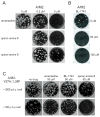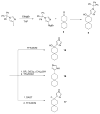Design and pharmacological characterization of inhibitors of amantadine-resistant mutants of the M2 ion channel of influenza A virus
- PMID: 19905033
- PMCID: PMC2794939
- DOI: 10.1021/bi9014488
Design and pharmacological characterization of inhibitors of amantadine-resistant mutants of the M2 ion channel of influenza A virus
Abstract
The A/M2 proton channel of influenza A virus is a target for the anti-influenza drugs amantadine and rimantadine, whose effectiveness was diminished by the appearance of naturally occurring point mutants in the A/M2 channel pore, among which the most common are S31N, V27A, and L26F. We have synthesized and characterized the properties of a series of compounds, originally derived from the A/M2 inhibitor BL-1743. A lead compound emerging from these investigations, spiro[5.5]undecan-3-amine, is an effective inhibitor of wild-type A/M2 channels and L26F and V27A mutant ion channels in vitro and also inhibits replication of recombinant mutant viruses bearing these mutations in plaque reduction assays. Differences in the inhibition kinetics between BL-1743, known to bind inside the A/M2 channel pore, and amantadine were exploited to demonstrate competition between these compounds, consistent with the conclusion that amantadine binds inside the channel pore. Inhibition by all of these compounds was shown to be voltage-independent, suggesting that their charged groups are within the N-terminal half of the pore, prior to the selectivity filter that defines the region over which the transmembrane potential occurs. These findings not only help to define the location and mechanism of binding of M2 channel-blocking drugs but also demonstrate the feasibility of discovering new inhibitors that target this binding site in a number of amantadine-resistant mutants.
Figures












Similar articles
-
An M2-V27A channel blocker demonstrates potent in vitro and in vivo antiviral activities against amantadine-sensitive and -resistant influenza A viruses.Antiviral Res. 2017 Apr;140:45-54. doi: 10.1016/j.antiviral.2017.01.006. Epub 2017 Jan 10. Antiviral Res. 2017. PMID: 28087313 Free PMC article.
-
Characterization of inhibition of M2 ion channel activity by BL-1743, an inhibitor of influenza A virus.J Virol. 1996 Jul;70(7):4246-52. doi: 10.1128/JVI.70.7.4246-4252.1996. J Virol. 1996. PMID: 8676445 Free PMC article.
-
Easily accessible polycyclic amines that inhibit the wild-type and amantadine-resistant mutants of the M2 channel of influenza A virus.J Med Chem. 2014 Jul 10;57(13):5738-47. doi: 10.1021/jm5005804. Epub 2014 Jun 30. J Med Chem. 2014. PMID: 24941437 Free PMC article.
-
Viral M2 ion channel protein: a promising target for anti-influenza drug discovery.Mini Rev Med Chem. 2014;14(10):819-30. Mini Rev Med Chem. 2014. PMID: 25342196 Review.
-
Tackling Influenza A virus by M2 ion channel blockers: Latest progress and limitations.Eur J Med Chem. 2024 Mar 5;267:116172. doi: 10.1016/j.ejmech.2024.116172. Epub 2024 Feb 3. Eur J Med Chem. 2024. PMID: 38330869 Review.
Cited by
-
Discovery of potential M2 channel inhibitors based on the amantadine scaffold via virtual screening and pharmacophore modeling.Molecules. 2011 Dec 8;16(12):10227-55. doi: 10.3390/molecules161210227. Molecules. 2011. PMID: 22158591 Free PMC article.
-
Antiviral Drugs in Influenza.Int J Environ Res Public Health. 2022 Mar 4;19(5):3018. doi: 10.3390/ijerph19053018. Int J Environ Res Public Health. 2022. PMID: 35270708 Free PMC article. Review.
-
Affinity of Rimantadine Enantiomers against Influenza A/M2 Protein Revisited.ACS Med Chem Lett. 2017 Jan 27;8(2):145-150. doi: 10.1021/acsmedchemlett.6b00311. eCollection 2017 Feb 9. ACS Med Chem Lett. 2017. PMID: 28217261 Free PMC article.
-
Functional reconstitution of influenza A M2(22-62).Biochim Biophys Acta. 2011 Feb;1808(2):516-21. doi: 10.1016/j.bbamem.2010.10.010. Epub 2010 Oct 20. Biochim Biophys Acta. 2011. PMID: 20969830 Free PMC article.
-
Coexistence of two adamantane binding sites in the influenza A M2 ion channel.Proc Natl Acad Sci U S A. 2010 Aug 3;107(31):13866-71. doi: 10.1073/pnas.1002051107. Epub 2010 Jul 19. Proc Natl Acad Sci U S A. 2010. PMID: 20643947 Free PMC article.
References
-
- Cox NJ, Subbarao K. Influenza. Lancet. 1999;354:1277–1282. - PubMed
-
- Deyde VM, Xu X, Bright RA, Shaw M, Smith CB, Zhang Y, Shu Y, Gubareva LV, Cox NJ, Klimov AI. Surveillance of resistance to adamantanes among influenza A(H3N2) and A(H1N1) viruses isolated worldwide. J Infect Dis. 2007;196:249–257. - PubMed
-
- Garten RJ, Davis CT, Russell CA, Shu B, Lindstrom S, Balish A, Sessions WM, Xu X, Skepner E, Deyde V, Okomo-Adhiambo M, Gubareva L, Barnes J, Smith CB, Emery SL, Hillman MJ, Rivailler P, Smagala J, de Graaf M, Burke DF, Fouchier RA, Pappas C, Alpuche-Aranda CM, Lopez-Gatell H, Olivera H, Lopez I, Myers CA, Faix D, Blair PJ, Yu C, Keene KM, Dotson PD, Jr, Boxrud D, Sambol AR, Abid SH, St George K, Bannerman T, Moore AL, Stringer DJ, Blevins P, Demmler- Harrison GJ, Ginsberg M, Kriner P, Waterman S, Smole S, Guevara HF, Belongia EA, Clark PA, Beatrice ST, Donis R, Katz J, Finelli L, Bridges CB, Shaw M, Jernigan DB, Uyeki TM, Smith DJ, Klimov AI, Cox NJ. Antigenic and Genetic Characteristics of Swine-Origin 2009 A(H1N1) Influenza Viruses Circulating in Humans. Science 2009 - PMC - PubMed
Publication types
MeSH terms
Substances
Grants and funding
LinkOut - more resources
Full Text Sources
Other Literature Sources

